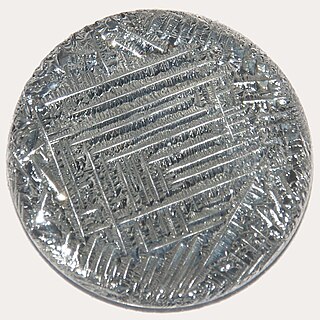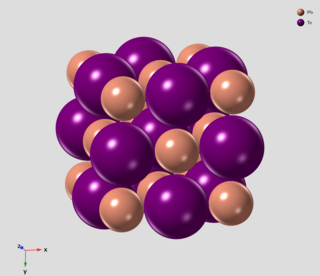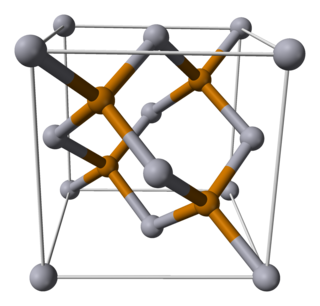
Tellurium is a chemical element; it has symbol Te and atomic number 52. It is a brittle, mildly toxic, rare, silver-white metalloid. Tellurium is chemically related to selenium and sulfur, all three of which are chalcogens. It is occasionally found in its native form as elemental crystals. Tellurium is far more common in the Universe as a whole than on Earth. Its extreme rarity in the Earth's crust, comparable to that of platinum, is due partly to its formation of a volatile hydride that caused tellurium to be lost to space as a gas during the hot nebular formation of Earth.

Thermoelectric cooling uses the Peltier effect to create a heat flux at the junction of two different types of materials. A Peltier cooler, heater, or thermoelectric heat pump is a solid-state active heat pump which transfers heat from one side of the device to the other, with consumption of electrical energy, depending on the direction of the current. Such an instrument is also called a Peltier device, Peltier heat pump, solid state refrigerator, or thermoelectric cooler (TEC) and occasionally a thermoelectric battery. It can be used either for heating or for cooling, although in practice the main application is cooling. It can also be used as a temperature controller that either heats or cools.

Thermoelectric materials show the thermoelectric effect in a strong or convenient form.

The Seebeck coefficient of a material is a measure of the magnitude of an induced thermoelectric voltage in response to a temperature difference across that material, as induced by the Seebeck effect. The SI unit of the Seebeck coefficient is volts per kelvin (V/K), although it is more often given in microvolts per kelvin (μV/K).

A semimetal is a material with a very small overlap between the bottom of the conduction band and the top of the valence band. According to electronic band theory, solids can be classified as insulators, semiconductors, semimetals, or metals. In insulators and semiconductors the filled valence band is separated from an empty conduction band by a band gap. For insulators, the magnitude of the band gap is larger than that of a semiconductor. Because of the slight overlap between the conduction and valence bands, semimetals have no band gap and a negligible density of states at the Fermi level. A metal, by contrast, has an appreciable density of states at the Fermi level because the conduction band is partially filled.

Tellurobismuthite, or tellurbismuth, is a telluride mineral: bismuth telluride (Bi2Te3). It crystallizes in the trigonal system. There are natural cleavage planes in the (0001) direction as the crystal is effectively lamellar (layered) in that plane. The Mohs hardness is 1.5 – 2 and the specific gravity is 7.815. It is a dull grey color, which exhibits a splendent luster on fresh cleavage planes.

Lead telluride is a compound of lead and tellurium (PbTe). It crystallizes in the NaCl crystal structure with Pb atoms occupying the cation and Te forming the anionic lattice. It is a narrow gap semiconductor with a band gap of 0.32 eV. It occurs naturally as the mineral altaite.

Mercury telluride (HgTe) is a binary chemical compound of mercury and tellurium. It is a semi-metal related to the II-VI group of semiconductor materials. Alternative names are mercuric telluride and mercury(II) telluride.

A thermoelectric generator (TEG), also called a Seebeck generator, is a solid state device that converts heat directly into electrical energy through a phenomenon called the Seebeck effect. Thermoelectric generators function like heat engines, but are less bulky and have no moving parts. However, TEGs are typically more expensive and less efficient. When the same principle is used in reverse to create a heat gradient from an electric current, it is called a thermoelectric cooler.

A topological insulator is a material whose interior behaves as an electrical insulator while its surface behaves as an electrical conductor, meaning that electrons can only move along the surface of the material.

Antimony telluride is an inorganic compound with the chemical formula Sb2Te3. As is true of other pnictogen chalcogenide layered materials, it is a grey crystalline solid with layered structure. Layers consist of two atomic sheets of antimony and three atomic sheets of tellurium and are held together by weak van der Waals forces. Sb2Te3 is a narrow-gap semiconductor with a band gap 0.21 eV; it is also a topological insulator, and thus exhibits thickness-dependent physical properties.

Alexander A. Balandin is an electrical engineer, solid-state physicist, and materials scientist best known for the experimental discovery of unique thermal properties of graphene and their theoretical explanation; studies of phonons in nanostructures and low-dimensional materials, which led to the development of the field of phonon engineering; investigation of low-frequency electronic noise in materials and devices; and demonstration of the first charge-density-wave quantum devices operating at room temperature.
Bismuth selenide is a gray compound of bismuth and selenium also known as bismuth(III) selenide.
In materials science, the term single-layer materials or 2D materials refers to crystalline solids consisting of a single layer of atoms. These materials are promising for some applications but remain the focus of research. Single-layer materials derived from single elements generally carry the -ene suffix in their names, e.g. graphene. Single-layer materials that are compounds of two or more elements have -ane or -ide suffixes. 2D materials can generally be categorized as either 2D allotropes of various elements or as compounds.

Molybdenum(IV) telluride, molybdenum ditelluride or just molybdenum telluride is a compound of molybdenum and tellurium with formula MoTe2, corresponding to a mass percentage of 27.32% molybdenum and 72.68% tellurium.
Lead tin telluride, also referred to as PbSnTe or Pb1−xSnxTe, is a ternary alloy of lead, tin and tellurium, generally made by alloying either tin into lead telluride or lead into tin telluride. It is a IV-VI narrow band gap semiconductor material.
Bismuth antimonides, Bismuth-antimonys, or Bismuth-antimony alloys, (Bi1−xSbx) are binary alloys of bismuth and antimony in various ratios.

In physics, Dirac cones are features that occur in some electronic band structures that describe unusual electron transport properties of materials like graphene and topological insulators. In these materials, at energies near the Fermi level, the valence band and conduction band take the shape of the upper and lower halves of a conical surface, meeting at what are called Dirac points.

Boron nitride nanosheet is a crystalline form of the hexagonal boron nitride (h-BN), which has a thickness of one atom. Similar in geometry as well as physical and thermal properties to its carbon analog graphene, but has very different chemical and electronic properties – contrary to the black and highly conducting graphene, BN nanosheets are electrical insulators with a band gap of ~5.9 eV, and therefore appear white in color.

Joseph P. Heremans is a condensed matter experimental physicist at The Ohio State University where he holds titles as Ohio Eminent Scholar and Professor in the Department of Mechanical and Aerospace Engineering, with courtesy appointments in the Department of Physics and Department of Materials Science and Engineering. He is a member of the National Academy of Engineering and fellow of the American Physical Society and the American Association for the Advancement of Science. His research focuses on magneto-transport, thermal, and thermoelectric properties of electrons, phonons, and spin in narrow-gap semiconductors, semimetals, and nanostructures. Prior to OSU, Heremans worked as a research scientist and research manager at GM Research Lab from 1984-1998 and the Delphi Research Labs (1999-2005), where he developed tunable IR diode lasers and magnetic sensors.
















